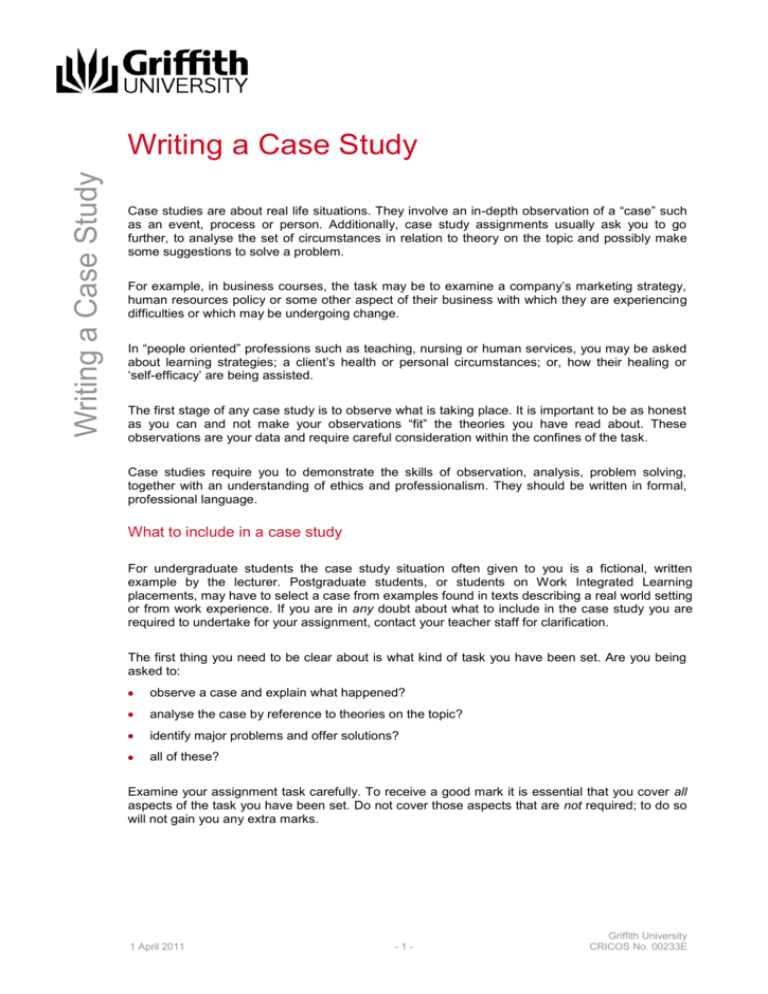
Writing a Case Study
Writing a Case Study
Case studies are about real life situations. They involve an in-depth observation of a “case” such
as an event, process or person. Additionally, case study assignments usually ask you to go
further, to analyse the set of circumstances in relation to theory on the topic and possibly make
some suggestions to solve a problem.
For example, in business courses, the task may be to examine a company‟s marketing strategy,
human resources policy or some other aspect of their business with which they are experiencing
difficulties or which may be undergoing change.
In “people oriented” professions such as teaching, nursing or human services, you may be asked
about learning strategies; a client‟s health or personal circumstances; or, how their healing or
„self-efficacy‟ are being assisted.
The first stage of any case study is to observe what is taking place. It is important to be as honest
as you can and not make your observations “fit” the theories you have read about. These
observations are your data and require careful consideration within the confines of the task.
Case studies require you to demonstrate the skills of observation, analysis, problem solving,
together with an understanding of ethics and professionalism. They should be written in formal,
professional language.
What to include in a case study
For undergraduate students the case study situation often given to you is a fictional, written
example by the lecturer. Postgraduate students, or students on Work Integrated Learning
placements, may have to select a case from examples found in texts describing a real world setting
or from work experience. If you are in any doubt about what to include in the case study you are
required to undertake for your assignment, contact your teacher staff for clarification.
The first thing you need to be clear about is what kind of task you have been set. Are you being
asked to:
observe a case and explain what happened?
analyse the case by reference to theories on the topic?
identify major problems and offer solutions?
all of these?
Examine your assignment task carefully. To receive a good mark it is essential that you cover all
aspects of the task you have been set. Do not cover those aspects that are not required; to do so
will not gain you any extra marks.
1 April 2011
-1-
Griffith University
CRICOS No. 00233E
Embedding the case study in theory
Relate the case you have been given to what you have already learned in your coursework.
Depending on the discipline in which you are studying, you may find that you are dealing with one
of the following:
Individual Theories – personality, behaviour, interaction.
Social Theories – groups, subcultures, social change in various contexts.
Organisational Theories – structures, procedures, performance in government or business,
bearing in mind relevant statutory or industry legislation.
Structuring the case study
Once you have decided the scope of the assignment you are dealing with, you will need to work
out a structure within which to present your answer clearly. This might include:
background to the case – the individual or the organisation you are studying and what has
happened that is of interest or concern.
your observations: not only what is going on but why, how, when and who is affected?
what the experts have to say about this topic. Do your observations align with theories on this
topic or not? Explore the similarities and differences.
what are your conclusions?
do you have recommendations? What are the reasons for your recommendations?
Case studies are usually presented in report format with sub-headed sections which may include
some or all of the following:
introduction
literature review
observations
discussion
conclusion/Recommendations
references
appendices
Further Reading
Cottrell, S. (2008). The study skills handbook (3rd ed.). London: Palgrave Macmillan.
Dul, J., & Halk, T. (2008). Case Study Methodology in Business Research. Oxford:
Butterworth-Heinemann.
Mulvaney, M., & Joliffe, D. (2005). Academic writing: genres, samples, and resources. New
York: Pearson Longman. (see Chapter 3 - Case Studies)
External Links
Colorado State University: http://writing.colostate.edu/guides/research/casestudy/
Monash University: http://www.monash.edu.au/lls/llonline/quickrefs/27-case-study.xml
University of Technology Sydney: http://www.bell.uts.edu.au/awg/case_studies
Additional learning tools / Sources of information
See www.griffith.edu.au/library/workshops-training/self-help-resources for further resources to
complement this information sheet.
© Griffith University 2011 Apart from fair dealing as permitted by the copyright law of your country, this work may be
reproduced in whole or in part for non-profit educational use, provided correct attribution is given. Abstracting with credit is
permitted. Other uses should be discussed with the copyright owner.
1 April 2011
-2-
Griffith University
CRICOS No. 00233E





